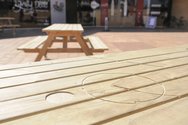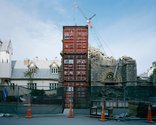Peter Dornauf – 11 March, 2013
Paton herself introduces the exhibition with reference to the problematic nature of public consultation in the business of constructing civic spaces. “Bureaucratised economic processes that occur behind closed doors” is how she characterizes it.
Ramp has had a revival, a restoration, a revamp. Enlarged and with a new glass frontage, the Wintec gallery is now actually looking like a gallery instead of a hole in the wall. This is a much overdue revitalisation given that billions have been spent elsewhere and long ago at the institution on upgrades and flash expensive new buildings.
To celebrate what the promos are calling “Hamilton’s leading contemporary art gallery”, the debut show for the new opening has ironically to do with planning, design and governance of public space. The exhibition, Public Good, curated by Kim Paton, is a group show featuring eight artists, each of which engage with issues of public planning in a variety of ways.
Paton herself introduces the exhibition with reference to the problematic nature of public consultation in the business of constructing civic spaces. “Bureaucratised economic processes that occur behind closed doors” is how she characterizes it. She points to the lack of connection between institutions (Governments and City Councils) and the public (the rightful owners) and the usual disparity between what the public say in the consultation process and what actually comes out at the other end.
One of the most telling pieces in the show that satirizes all that can be wrong, contradictory and fallacious in design practice, is the work of photographer David Cook (Wintec tutor). His collaged photograph of an ornamental tree at The Base (Hamilton’s newest burgeoning mega shopping centre and rival to the CBD ) shows a photo of a sapling tree trunk encased in a cage of protective metal, located at The Base, while the branches reach up into the space of a second photograph depicting happy outdoor adventure campers frolicking in the bush - the shot of the laughing couple is obviously borrowed from an advertisement adorning one of the outlets selling outdoor camping gear. Ironic in every way.
Others like Matthew Galloway, also poke the borax. His The City That Shines logo (Hexis Mirror Vinyl) pasted on the outer facings of the new gallery wall, mocks all that is shiny, cheap, fatuous, false and artificial about the usual city promos.
Gareth Williams does what’s become an almost ubiquitous examination of colonial immigrant history with his Domestic Tools for a European Immigrant. Shades of Michel Parekowhai. A block of small black granite against which lean brass miniatures of nineteenth century tools - pitchfork, rake, scythe, etc, takes on the whole debate about landscape configuration and its cultural permutations that has become in recent years part of the furniture of controversy and polemic in this country.
What would be a show like this be without a few cubes thrown in, representative of urban planning and design. Charlotte Watson’s Proto, 2013, (medium density flexible foam) addresses the issue of modernism with her interlocking model cubes. One is made to recall the international style that predominated for half a century with its utopic dreams that finally turned sour. Postmodern architectural design seems hardly to have reached our shores. Certainly not in Hamilton.
Of course the current controlling focus in urban design in this country has to be Christchurch and the rebuild after the earthquake. What to pull down? What to leave up? What to rebuild in its place? A cardboard cathedral, anyone?
Tim Veling does before and after take photographs of Christchurch, using Google map images from 2007, juxtaposed against the same place post-earthquake. His Saint John the Baptist Church, Hereford Street, 2012, captures not only the poignancy of the destruction - a heaped collection of broken masonry together with a jumble of fancy wrought iron fencing dumped in a wasteland - but also presents a graphic contiguity of nineteenth century Victoriana that confronts the present twenty first century. What to do?
The most enigmatic and even obscure piece in the show was Tim Middleton’s work with the equally intriguing title Universal Space Bus. The piece itself which looks neither like a bus nor particularly universal, was a rather shabby looking surfboard, painted white. In fact it was a cast of the artists own well used board. Middleton is, in his own words, or near enough to them, “attempting to unleash the poetic resonance of everyday objects, distinct from use or value”. Reminiscent of Pop artist, Claes Oldenburg who did the same thing only with more cheek, there’s a political kick to this wave riding mould in its link to the current issue of coastline ownership and public access in New Zealand.
Even though enlarged, the new gallery wasn’t big enough to contain the work of Raewyn Martyn and her Ways to play a table, 2013, which is on display at the Waikato Museum forecourt. She has taken those generic wooden assembled and butt ugly picnic tables that one sees in public rest areas and simply cut into the table top in a sort of graffiti-like way. Enough said. Though the markings the artist makes are more like hieroglyphics which she regards as ‘maps’ or signs of occupation.
This is the sort of show City Councillors should have been lining up in droves to see. One attended, though I’m told several city planners put in an appearance. The show raises important questions, but, as is the case with most art, provides no answers. Or maybe the questions themselves make the answers obvious.
On-going publications related to Public Good will be a feature over the next twelve months together with a series of exhibitions that extend and deal with the same subject. This is a timely show that sets the tone for the new gallery space at an institution connected to the practical arts.
Peter Dornauf















 Two Rooms presents a program of residencies and projects
Two Rooms presents a program of residencies and projects Advertising in this column
Advertising in this column



This Discussion has 0 comments.
Comment
Participate
Register to Participate.
Sign in
Sign in to an existing account.